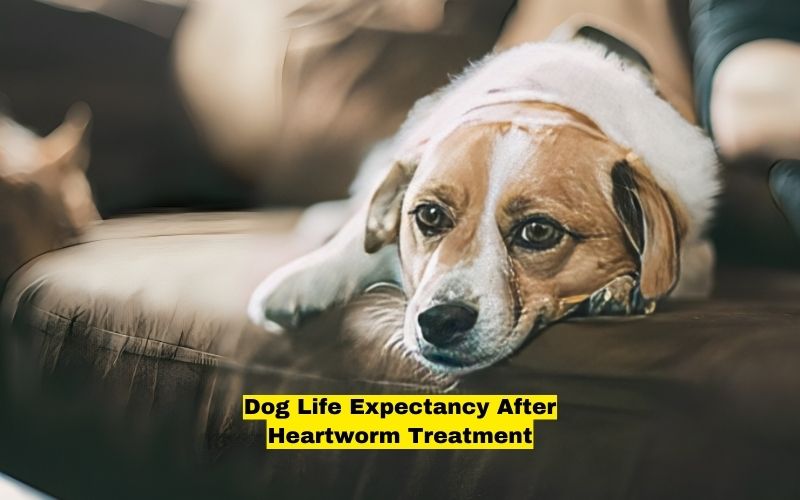Heartworm disease is a serious and potentially fatal condition that affects dogs. Caused by the parasitic worm Dirofilaria immitis, heartworm disease is transmitted through the bite of an infected mosquito. Once inside the dog’s body, the larvae migrate to the heart and lungs, where they mature into adult worms, causing severe damage to the cardiovascular system.
The treatment for heartworm disease is complex and can be demanding for both the dog and the owner. However, with prompt and appropriate treatment, many dogs can recover and go on to live healthy lives. This article explores the factors affecting dog life expectancy after heartworm treatment, the treatment process, and how to care for a dog post-treatment to ensure the best possible outcome.
Understanding Heartworm Disease
Lifecycle of Heartworms
Heartworms go through several stages during their lifecycle. Here’s a brief overview:
- Transmission: A mosquito bites an infected animal, ingesting microfilariae (heartworm larvae).
- Development: The larvae develop inside the mosquito and become infective within 10-14 days.
- Infection: The mosquito bites a dog, transmitting the infective larvae into the dog’s bloodstream.
- Migration: The larvae migrate through the dog’s tissues and reach the heart and lungs within 6 months.
- Maturation: The larvae mature into adult worms, reproduce, and release microfilariae into the bloodstream, continuing the cycle.
Symptoms of Heartworm Disease
The severity of symptoms depends on the number of worms, the duration of infection, and the dog’s overall health. Common symptoms include:
- Coughing
- Fatigue and weakness
- Weight loss
- Difficulty breathing
- Swollen abdomen due to fluid accumulation
- Heart failure
In some cases, dogs may remain asymptomatic in the early stages of infection. This makes regular heartworm testing critical, especially in areas where heartworm disease is prevalent.
Heartworm Treatment
Diagnostic Process
Before treatment, a thorough diagnosis is essential. This typically involves:
- Blood Tests: To detect the presence of microfilariae or heartworm antigens. The two primary tests are the microfilariae test, which looks for the presence of young heartworms, and the antigen test, which detects proteins from adult female heartworms.
- X-Rays and Ultrasound: To assess the extent of damage to the heart and lungs. X-rays can reveal changes in the heart’s size and shape, while ultrasound provides detailed images of the heart and the surrounding blood vessels.
- Physical Examination: To evaluate the dog’s overall health and suitability for treatment. This includes checking for signs of heart failure, liver or kidney dysfunction, and other health conditions that could complicate treatment.
Treatment Protocols
Treatment for heartworm disease usually involves several steps:
- Stabilization: If the dog is in poor condition, initial treatment focuses on stabilizing their health. This may include medications to manage symptoms such as coughing, heart failure, and secondary infections.
- Adulticide Therapy: Medications like melarsomine (Immiticide) are used to kill adult heartworms. This is administered through a series of injections. The standard protocol involves two injections 24 hours apart, but in more severe cases, a three-injection protocol may be recommended.
- Microfilaricide Therapy: After killing adult worms, a separate treatment targets microfilariae in the bloodstream. This often involves the use of heartworm preventatives that also eliminate microfilariae.
- Doxycycline: This antibiotic is given to eliminate Wolbachia, bacteria that live symbiotically within heartworms and are essential for their reproduction. By targeting Wolbachia, the treatment reduces the worm’s ability to reproduce and enhances the effectiveness of adulticide therapy.
- Preventive Measures: Continuous use of heartworm preventatives to avoid reinfection. This includes monthly preventatives such as ivermectin, milbemycin, moxidectin, or selamectin.
Risks and Side Effects
Heartworm treatment, particularly adulticide therapy, carries some risks, including:
- Severe inflammatory response as the worms die and are broken down by the body. This can lead to a condition called thromboembolism, where fragments of dead worms cause blockages in blood vessels.
- Potential for embolism (blockage of blood vessels) caused by dead worms. This can lead to complications such as pulmonary embolism, which can be life-threatening.
- Adverse reactions to medications, such as vomiting, diarrhea, or lethargy. Some dogs may also experience allergic reactions to the breakdown products of the worms.
To mitigate these risks, veterinarians may recommend hospitalization during the critical period following adulticide injections and prescribe anti-inflammatory medications and strict activity restrictions.
Post-Treatment Care
Recovery Period
The recovery period following heartworm treatment is crucial. Dogs require strict rest and limited physical activity for several weeks to months to prevent complications. This is because physical activity increases blood flow, which can dislodge dead worm fragments and cause embolism.
Monitoring and Follow-Up
Regular follow-up visits to the veterinarian are essential to monitor the dog’s recovery and detect any potential complications. Blood tests and imaging may be repeated to ensure all heartworms are eliminated and assess any lingering damage. A recheck, usually involving an antigen test, is typically done six months after treatment to confirm the absence of adult heartworms.
Lifestyle Adjustments
Post-treatment, some lifestyle adjustments are necessary:
- Controlled Exercise: Gradual reintroduction of exercise based on the veterinarian’s guidance. Initially, dogs should be confined to a crate or small room and only allowed brief, leashed walks.
- Heartworm Preventatives: Continuous use of heartworm preventatives to prevent reinfection. This is crucial to ensure the dog does not get re-infected while its immune system is still recovering.
- Regular Check-Ups: Routine veterinary visits to monitor the dog’s health and prevent future issues. This includes annual heartworm testing and physical exams.
See Also: Best Pet Food for Chow Chows
Factors Affecting Life Expectancy After Treatment
Severity of Infection
The severity of the infection at the time of diagnosis significantly impacts the dog’s prognosis. Dogs with mild to moderate infections generally have a better outlook than those with severe infections or advanced heartworm disease. Severe infections can lead to more significant damage to the heart and lungs, which can reduce the dog’s life expectancy even after successful treatment.
Timeliness of Treatment
Early detection and prompt treatment are critical for a favorable outcome. Delayed treatment increases the risk of severe damage to the heart and lungs, which can reduce life expectancy. Regular screening and preventive measures are essential to catch the disease early.
Overall Health and Age
A dog’s overall health and age also play a role in their recovery and life expectancy. Younger, healthier dogs tend to recover better and have a longer life expectancy post-treatment compared to older dogs or those with pre-existing health conditions. Older dogs or those with concurrent health issues may have a harder time recovering fully from the damage caused by heartworms.
Adherence to Post-Treatment Care
Strict adherence to post-treatment care instructions, including controlled exercise, regular veterinary follow-ups, and continuous use of heartworm preventatives, is essential for ensuring a successful recovery and long-term health. Failure to follow these guidelines can lead to complications and reduced life expectancy.
Complications and Long-Term Effects
Some dogs may experience complications or long-term effects from heartworm disease and its treatment, such as:
- Pulmonary Thromboembolism: Blockage of blood vessels in the lungs caused by dead worms, leading to respiratory issues. This can cause sudden, severe respiratory distress and can be life-threatening if not treated promptly.
- Chronic Heart or Lung Damage: Persistent damage to the heart or lungs can affect the dog’s quality of life and longevity. This can include chronic heart failure, pulmonary hypertension, and fibrosis of lung tissues.
- Renal Complications: In rare cases, heartworm disease can lead to kidney damage. This is often due to immune-mediated reactions to the heartworms or their byproducts.
Improving Life Expectancy Post-Treatment
Preventative Measures
The best way to ensure a long and healthy life for a dog post-treatment is to prevent reinfection. This includes:
- Year-Round Preventative Medication: Administering heartworm preventatives consistently throughout the year. This is crucial even in colder climates, as mosquitoes can survive indoors.
- Regular Testing: Annual heartworm testing to detect any potential reinfection early. This ensures that any new infection is caught and treated before it can cause significant damage.
- Environmental Control: Reducing mosquito exposure by keeping dogs indoors during peak mosquito activity times and using mosquito repellents or treatments in the home and yard. Eliminating standing water and maintaining a clean yard can also help reduce mosquito breeding grounds.
Nutritional Support
Providing a balanced and nutritious diet supports overall health and aids in recovery. Consult with a veterinarian for dietary recommendations tailored to the dog’s specific needs and health status. A diet rich in high-quality protein, essential fatty acids, and antioxidants can support the immune system and promote healing.
Regular Exercise
Once the dog has fully recovered and received clearance from the veterinarian, regular exercise helps maintain cardiovascular health and overall well-being. However, it should be introduced gradually and tailored to the dog’s fitness level and health status. Activities such as short walks, gentle play, and low-impact exercises like swimming can be beneficial.
Monitoring and Managing Symptoms
Being vigilant about monitoring the dog’s health and promptly addressing any symptoms or changes in behavior is essential. Regular veterinary check-ups and open communication with the veterinarian help manage any potential issues before they become serious. Signs of trouble can include coughing, difficulty breathing, fatigue, and changes in appetite or behavior.
Emotional Support
Emotional well-being is as important as physical health. Providing a loving and stress-free environment contributes to a dog’s recovery and overall quality of life. Ensuring plenty of social interaction, mental stimulation, and affection can make a significant difference. Activities such as interactive toys, training exercises, and spending quality time together can help keep a dog mentally stimulated and happy.
Conclusion
Heartworm disease is a serious condition, but with prompt and appropriate treatment, many dogs can recover and lead healthy lives. Factors such as the severity of infection, timeliness of treatment, overall health, and adherence to post-treatment care significantly impact a dog’s life expectancy post-treatment. By taking preventive measures, providing nutritional and emotional support, and ensuring regular veterinary care, dog owners can enhance their pets’ chances of a long, healthy life after heartworm treatment.
While the road to recovery can be challenging, the reward of seeing a beloved pet regain health and vitality is immeasurable. With the right care and attention, dogs can overcome heartworm disease and continue to bring joy and companionship to their families for many years to come.




